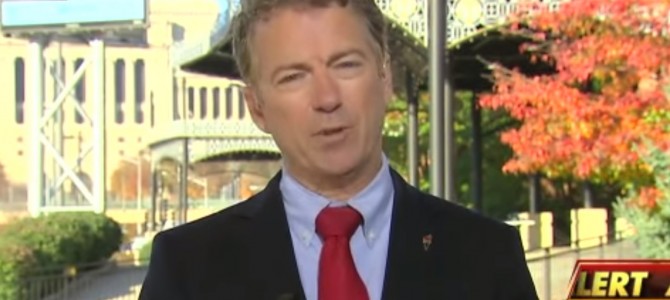
Since I recently criticized presidential candidates Rand Paul and Ted Cruz for inserting value-added taxes into their tax reform plans, it may seem odd that I’m now going to praise them. But they deserve credit for criticizing the Federal Reserve.
Cruz took aim at the Fed’s “philosopher kings” at the recent GOP debate, while Paul has been a long-time critic, as illustrated by his proposal to “audit the Fed.” This irks some folks, who seem to think Fed critics are knuckle-dragging rubes and yahoos with a superstitious fealty to the gold standard. Writing in The Atlantic, Gillian White mocks the two senators.
Both Rand Paul and Ted Cruz have broached the idea…as part of their monetary policy in the past few months. …the gold standard is a bad idea. …In the short term, linking dollars to gold quantities can produce a currency that’s pretty volatile. …why is this rejected plan popping up…?
White actually answers her own question. The dispute isn’t really about a gold standard, but whether the Federal Reserve should have lots of discretionary power.
The conversations about gold in recent years are perhaps less about the belief that it’s actually smart policy and more about condemning and rejecting the power of the government, through the Federal Reserve, to control the printing of money and the setting of interest rates. …Many economists see the power to manipulate policy in reaction to the ups and downs of the economy as the natural evolution… The purpose of this power is to ward off or lessen financial disasters through keeping rates artificially low or introducing more money into the system, or doing the opposite to rein in inflation during periods of growth.
This is a fair debate. On one side are the advocates of Fed discretion, which is basically the monetary component of Keynesian economics. Proponents explicitly want the Fed to fine-tune and micromanage the economy. This is why we get endless navel-gazing speculation about whether Federal Reserve Chairman Janet Yellen might decide to raise interest rates.
On the other side are folks who believe in rules to limit the Fed’s powers, not because they have some reflexive hostility to government, but because they believe discretionary power is more likely to give us bad results such as higher price inflation, volatility in output and employment, and financial instability. Consider last decade’s housing bubble, for instance, which almost certainly was aided and abetted by former Federal Reserve Chairman Alan Greenspan’s easy-money policy. Or the boom-bust, inflation-stagnation occurrences the Fed caused in the 1970s.
In hopes of preventing this type of economic damage, people on this side of the discussion are drawn to policies or rules that would inhibit discretionary monetary policy.
Stability Is More Important than Gold
A recent report from the Joint Economic Committee explains why a rules-based approach is preferable.
Well-reasoned, stable and predictable monetary policy reduces economic volatility and promotes long-term economic growth and job creation. Generally, ‘rules-based’ policies reduce uncertainties and facilitate long-term planning and investment. …Conversely, activist, interventionist, and discretionary monetary policies have been historically associated with increased economic volatility and subpar economic performance.
To be sure, picking the right rule can be a challenge. The gold standard is widely criticized, yet Professor George Selgin has explained that it actually was very successful. That being said, George is not a big advocate, for the simple reason that he doesn’t think governments can be trusted to let it operate.
Other options include Milton Friedman’s “K-percent rule,” which would eliminate Fed discretion by requiring the Fed to increase the money supply by a predetermined amount each year. Another choice is explicit inflation targeting, which was first implemented in New Zealand.
There’s also the “Taylor rule,” a version of inflation targeting that would require the Fed to adjust interest rates based on changes in inflation relative to the target inflation rate and actual real gross domestic product growth relative to the potential real GDP growth rate.
This isn’t an exhaustive list of options. Instead, it’s simply designed to highlight the rigorous and credible nature of rule-based monetary policy. All of these rules have one thing in common. They’re designed to handcuff the Fed so that monetary policy promotes price stability.
Paul and Cruz may not be experts on monetary policy, just as left-wing senators doubtlessly have no understanding of the intricacies of discretionary monetary policy. But the two senators are on very solid ground, with an illustrious intellectual lineage, when they assert that it would be a good idea to constrain the Fed.
By the way, some of us curmudgeonly libertarians like to push the policy envelope. As such, we would argue that Paul and Cruz are being too timid and that the debate over rules versus discretion should be secondary to the issue of whether governments should have a monopoly over money. Competitive private currencies were quite successful before national governments regulated them out of business.








